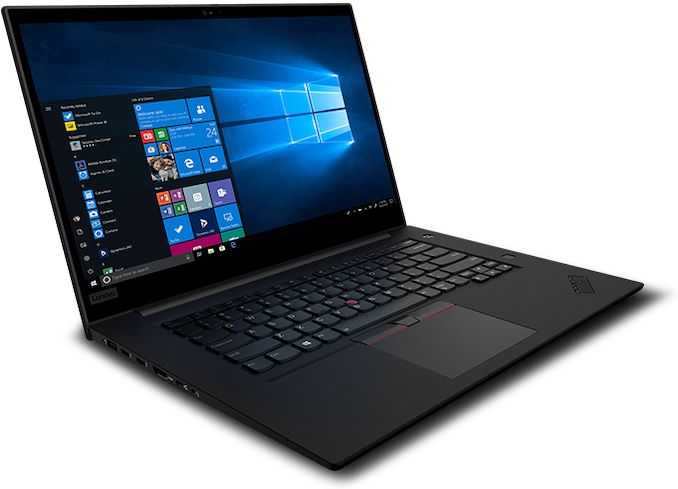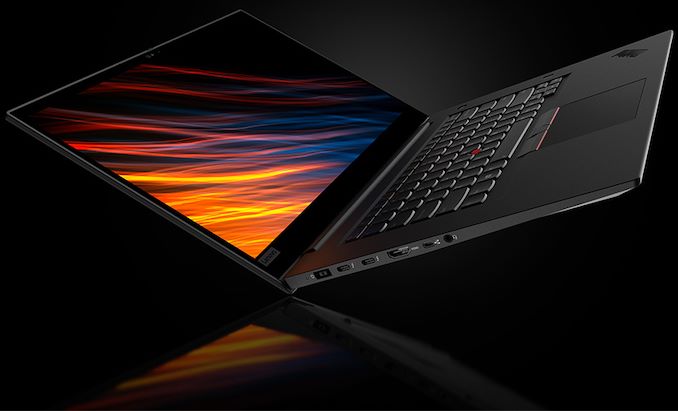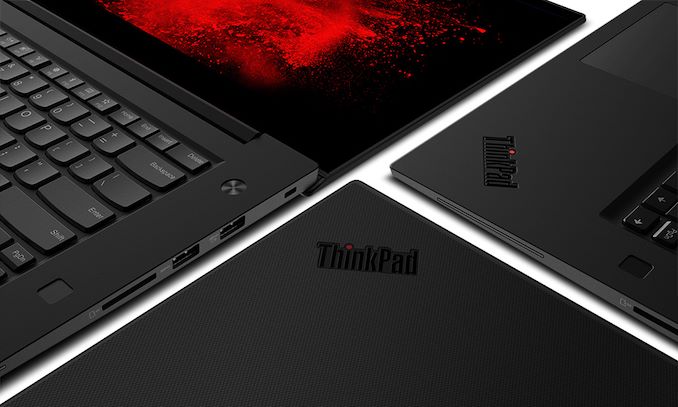Lenovo Unveils ThinkPad P1 Gen 2: New 15.6-Inch Carbon Fiber Chassis
by Anton Shilov on June 12, 2019 4:00 PM EST- Posted in
- Notebooks
- Lenovo
- ThinkPad
- Quadro
- Laptops
- NVIDIA
- Coffee Lake-H
- ThinkPad P1

Lenovo has introduced its second-generation ultra-thin ThinkPad P1 mobile workstation. The new 15.6-inch laptop promises to be faster than its predecessor launched last year because of the new CPU and GPU, yet it will use a new carbon fiber chassis that is actually thinner and slightly lighter.
Lenovo’s ThinkPad P1 Gen 2 is based on Intel’s 9th Gen Core or Xeon processor that is paired with up to 64 GB DDR4 memory with or without ECC (up to two SO-DIMMs), NVIDIA’s Quadro T1000 or Quadro T2000 graphics on higher-end SKUs, and up to two M.2 SSDs (featuring up to 4 TB of NAND in total) with a PCIe 3.0 x4 interface and working in RAID 0 or RAID 1 mode.
Just like in case of the first-generation ThinkPad P1, the new 15.6-inch ultra-thin workstation will be offered with several types of displays. The most advanced models will come with an Ultra-HD OLED display supporting touch and Dolby Vision HDR, whereas regular SKUs will be equipped with Full-HD IPS LCDs.
As for connectivity, the Lenovo ThinkPad P1 has Intel’s AX200 Wi-Fi 6 solution featuring up to 2.4 Gbps throughput over 160 MHz channels. As for hardware interfaces, the ThinkPad P1 Gen 2 is equipped with two Thunderbolt 3 ports, two USB 3.1 Gen 1 Type-A connectors, a mini GbE port (requires a dongle), an HDMI 2.0 output, an optional smart card reader, a 4-in-1 card reader, a webcam with IR and ThinkShutter, a fingerprint scanner, and a 3.5-mm audio port.
The ThinkPad P1 Gen 2 comes in a new carbon fiber chassis that is 17.2 mm thick, down from 18.4 mm on the first-generation model. Traditionally for ThinkPads, the chassis is rugged enough to take bumps of everyday use by a road warrior and can withstand cold, heat, humid, dust, fungus, shocks and other harsh environments. Despite being slightly thinner than predecessors, the ThinkPad P1 Gen 2 still has an 80 Wh battery and weighs around 1.7 kilograms.
The ThinkPad P1 Gen 2 will ship at the end of June, starting at $1,949.
| Lenovo's ThinkPad P1 Gen 2 | |||
| ThinkPad P1 Gen 2 FHD | ThinkPad P1 Gen 2 4K UHD | ||
| Display | Type | IPS | OLED |
| Resolution | 1920×1080 | 3840×2160 | |
| Brightness | 300/500 cd/m² | 400 cd/m² | |
| Color Gamut | 72% NTSC | ? | |
| Touch | No | Yes | |
| HDR | No | Dolby Vision HDR | |
| CPU | Intel's 9th Generation Core i7/i9 or Xeon | ||
| Graphics | Integrated | UHD Graphics 620 (24 EUs) | |
| Discrete | NVIDIA Quadro T1000 or T2000 | ||
| RAM | up to 64 GB DDR4 | ||
| Storage | up to 4 TB PCIe SSDs with RAID 0/RAID 1 | ||
| Wi-Fi | Intel Wireless AX200 2.4 Gbps | ||
| Bluetooth | Bluetooth 5 | ||
| Thunderbolt | 2 × USB Type-C TB3 ports | ||
| USB | 2 × USB 3.1 Gen 1 Type-A | ||
| HDMI | HDMI 2.0 | ||
| GbE | Native, with a dongle | ||
| Fingerprint Sensor | Yes | ||
| Webcam | HD camera with ThinkShutter HD camera with IR for Windows Hello and ThinkShutter |
||
| Other I/O | Microphone, stereo speakers, TRRS audio jack (with Dolby Atmos enhancements for appropriate headphones), joystick, trackpad, card reader, etc. | ||
| Battery | 80 Wh | ||
| Dimensions | Thickness | 17.2 mm | |
| Width | 361.8 mm | ||
| Depth | 245.7 mm | ||
| Weight | 1.7 kilograms | 3.76 lbs | ||
| Operating System | Windows 10 Pro | ||
Related Reading:
- Lenovo Launches Ultra-Thin ThinkPad P1: X1 Carbon Meets Workstation
- Lenovo's Halo: The ThinkPad X1 Extreme Announced
- Lenovo Unveils ThinkPad X1 Extreme Gen 2: New CPU, GPU, OLED Display Option
- Lenovo ThinkStation P720 & P920 now with Cascade Lake & Quadro RTX 8000
- Lenovo at CES 2019: 7th Gen ThinkPad X1 Carbon Gets Thinner
Source: Lenovo














18 Comments
View All Comments
zinfamous - Wednesday, June 12, 2019 - link
how much horsepowers does the carbon fiber chasis add?Sttm - Wednesday, June 12, 2019 - link
Carbon fiber doesn't improve horsepower, it increases your power to weight ratio though.R0H1T - Wednesday, June 12, 2019 - link
Say Hello to My Little Friend -> Sarcasm 🙃Byte - Thursday, June 13, 2019 - link
/s aside, a very important figure for on the go notebook workstations.zinfamous - Thursday, June 13, 2019 - link
well if it doesn't increase my horsepower, then why did I spend all that $$$$ on those go faster stripes? ....but you're right. I should have asked how many seconds it will knock off of my 0-60, just as I clicked submit. This is what happens when we can't edit commentsZoZo - Wednesday, June 12, 2019 - link
Could they stop putting reflective touchscreens on 4K? This is supposed to be a thin and light workstation, why isn't there a non-glare 4K option?Why do they assume that a non-360 device needs to be used as touch screen just because it has higher pixel density?
zentwo - Wednesday, June 12, 2019 - link
The 4K display is OLED and I do not know of any matte OLED screen. So, since it seems like it has to be glossy anyway, better have the touch layer than not having it.grant3 - Wednesday, June 12, 2019 - link
No screen "has" to be glossy. It's simply a decision whether to add a matte surface or not. Matte is very unpopular, especially on high-definition displays, because worsens image quality.Best you can do is buy & install some kind of semi-gloss screen cover.
Byte - Thursday, June 13, 2019 - link
can put apples nano etching, only $1k extra...GiantPandaMan - Thursday, June 13, 2019 - link
Matte doesn't work well with touch either. It looks like a greasy mess extraordinarily fast.